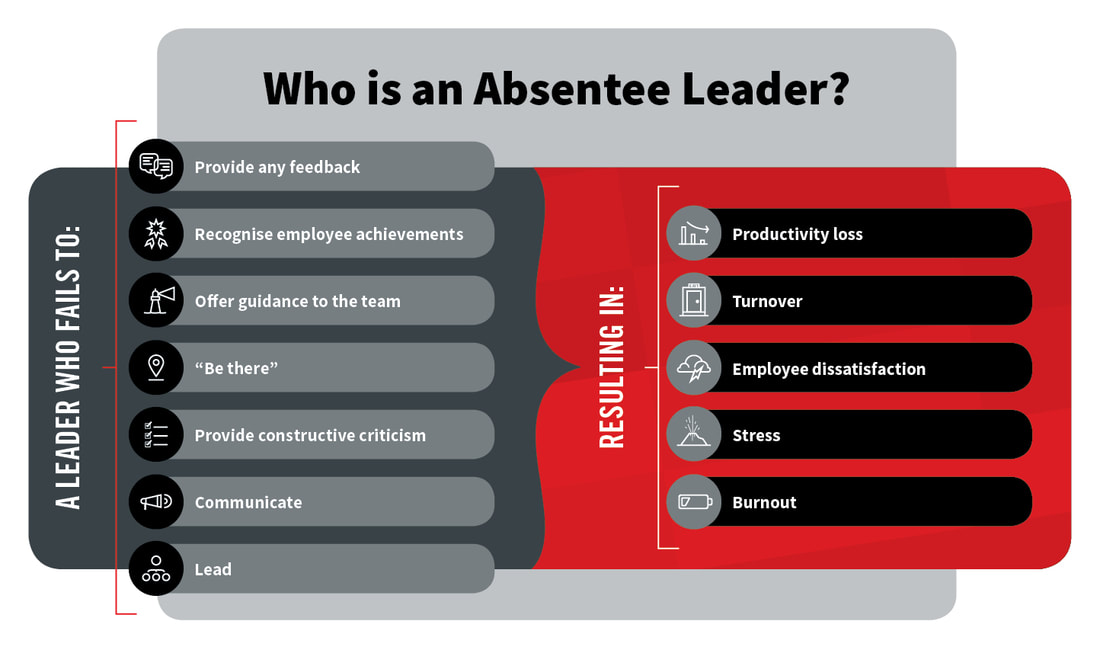Absentee leaders have been highlighted as a detriment to a workforce, with employees criticising this type of leadership more so than other forms of poor management.
This article focuses on the impact that absentee leadership can have on an organisation, and how companies should avoid it.
What is an Absentee Leader?
In short, an absentee leader is in the office in body but not in mind or spirit.
A recent Forbes article described absentee leadership as ‘emotional disengagement’ with their role and purpose.
While this ‘leader’ may be present, their lack of guidance or advice to staff as a mentor and management figure can make a lasting impact on their team and company.
While troublesome staff members are often guilty of disciplinary-worthy actions, absentee leaders can often become detrimental for an organisation on a long-term basis.
Whether it’s frequently cancelled meetings, multiple unanswered emails or little to no feedback, a leader who maintains an absent attitude to their role, their staff and their organisation can leave a lasting impact.
How can Absentee Leaders Impact their Staff?
Just as absentee leaders project a poor attitude, fellow staff can become demotivated towards their work or their role within an organisation. By not receiving appropriate feedback, staff may struggle to imagine a future within an organisation.
Not only can their own staff become impacted, but fellow senior leaders may be forced to pick up an absentee leader’s workload. Other managers who may also be causing trouble in more obvious ways will be focused upon, allowing absentee leaders to continue their poor management, leading to consequences for an organisations in the future.
What about Organisational Impact?
Poor management from an absentee leader may take some time to impact an organisation, but the consequences can be bad news for any company.
With demotivated staff comes an unproductive organisation. The Workforce View in Europe 2018 found that absentee leaders were one of the worst causes of unproductivity for organisations.
As staff become disenchanted with an organisation and how it is managed, many may consider or follow through leaving. Not only will this result in a loss of talent, but a company could face significant skill shortages.
An organisation’s performance will also inevitably suffer. While some managers face criticism for ‘micromanaging’, absentee leaders can lead to a toxic reduction in an organisation and its standing with its publics.
How can Absentee Leaders ruin your Organisation?
Hogan Assessments CEO Scott Gregory has shed light on the top five ways that an absentee leader can affect, or even ruin an organisation.
With a simple infographic, the consequences of failing to deal with absentee leaderships are plain to see.

If an absentee leader fails to ensure staff are certain of their role and purpose, this will affect organisational productivity in the near future. By failing to provide feedback, absentee leaders can cause uncertainty for staff on their own performance, and their responsibilities within their own roles.
Other ways in which an organisation may be ruined by absentee leadership is increased employee dissatisfaction and staff turnover. A lack of feedback or understanding can lead to demotivation. In turn, staff will seek career fulfilment elsewhere, affecting an organisation’s ability to retain talent and superior performance over competitors.
Absentee leaders can cause further stress for staff. As job dissatisfaction rises, staff burnout can become inevitable, affecting staff health as they tackle increasing workloads as a result of frequent staff turnover.
What should you do about it?
Absentee leaders are clearly toxic for any organisation and its staff. If their own leadership is not engaged and ready to serve their purpose, other staff will become demotivated and follow suit. As job dissatisfaction increases, staff turnover will follow, leading to skills shortages and performance reduction.
Organisations should protect their own reputation amongst both internal and external publics. If an absentee leader is identified, an organisation should strive to understand why they disengaged in the first place and work to motivate this person towards their role and purpose with an organisation.
By taking a top down approach to this HR issue, organisations can ensure their success continues, and that all staff are certain and motivated towards their roles.
For more helpful HR tips and advice, CLICK HERE to sign up to our weekly newsletter.




 RSS Feed
RSS Feed